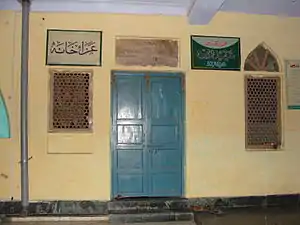Mirza Muhammad Kamil Dehlavi
Hakim Mirza Muhammad Kamil Dehlavi (d. 1809/10), also known as Shahid Rabay (The Fourth Martyr) was an Indian Shia author and a practitioner of Unani medicine in Delhi.[1][2]

Burial Chamber of Mirza Muhammad Kamil Dehlavi at Panja Sharif, Kashmiri Gate, Delhi
Nuzhat-e-Isna Ashariya
He authored Nuzhat-e-Isna Ashariya (نزھۃ اثنا عشريۃ), a complete response to Shah Abdul Aziz Dehlavi's Tauhfa Ithna Ashari.[3] It was due to this book that he was poisoned by the Sunni ruler Nawab of Jhajjhar of Indian state of Jhajhar.[4][5] He also wrote more than 60 books besides Nuzhat–e-Isna Ashariya.[2][6]
He is buried at dargah Panja Sharif at Kashmiri Gate, Delhi; alongside him Mufassir-e-Quran Maulana Syed Maqbool Ahmad Dehlavi too is buried.[7][8] Every year Delhi Shia Waqf Board arranges a five majalis session in the memory of Mirza Muhammad Kamil Dehlavi.
See also
References
- "Dehlavi". search.library.uitm.edu.my. 1989. Retrieved 30 September 2022.
- Rahman, Prof Hakim Syed Zillur; Virk, Zakaria (1 January 2021). "History of Unani Medicine in Dehli 17th Century to 20th Century". History of Unani Medicine in Dehli. Aligarh: Ibn Sena Academy of Medieval Medicine and Sciences. Retrieved 30 September 2022.
He was son of Ghayas al-Din Ahmad Dehlvi, a remarkable intellectual who was a member of a scholarly family. In medicine he was a disciple of Hakim Sharif Khan. His father was also a reputable scholar who composed poetry. Kamil was a disciple of Meer Shams al-Deen Faqeer (author Hada'iq al-Balaghat) and Maulana Syed Raham Ali (author of Badr al-Duja). Muhammad Hussain Azad (1910) has mentioned in Aab-e-Hayat one of Kamil's comprehensive tomes 'Elm-e-Qawafee'. As a rebuttal to controversial book Tuhfa Isna Asha'ariyya by Sunni scholar Shah Abdul Aziz (d1824) Hakim Kamil composed Nuzah Isna Ashariyya (Gift of Twelvers). Last three chapters were still unfinished that he breathed his last. Nuzha Isna Asha'ariyya has been translated into Urdu - Hadya Athna Ashariyya. Teaching and compiling books was his favorite pastime. He authored more than 60 works on jurisprudence (fiqh), kalam/dialectics ( Islamic scholastic philosophy ), hadith and philosophy. Manuscript of volume six of bulky book Nuzhat al-Nazirin is in Raza Library, Rampur. His biography is included in Najum al-Sama'a. Syed Ijaz Husain has written his biography in Persian. He was a good practitioner of Unani medicine and ran a busy clinic. Indian independence activist Maulvi Muhammad Baqir, first journalist to sacrifice his life during the 1857 revolt – father of prose writer Muhammad Husain Azad (1830-1910) always turned to him for medical advice. Hakim Kamil composed Hall al-Tashkikat in order to elucidate those portions of Burhan al-Din Nafis Kirmani book Sharh Mojiz known as Nafisi that were doubtful in its meaning. A rare copy of this 139 page book compiled in 1804 is in Raza Library, Rampur. It is reported that Nawab of Jhajhar – Abdur Rahman – invited him to Jhajhar (district Rohtak) and then had him poisoned to death as retaliation for composing the book Nuzha. He has been conferred the title of Shaheed Rabay (the fourth martyr of Shia Islam). His tomb in the shrine of Panja Shareef is visited by the thousands, located inside the Moree Darwaza Dehli.
- Nadvī, Abulḥasan ʻAlī (1993). Saviours of Islamic Spirit, Volume 4 (PDF) (The University of Michigan ed.). Academy of Islamic Research and Publications. pp. 262, 315. Archived from the original on 30 September 2022. Retrieved 4 July 2020.
- Muhammad Hussain Najafi, Ahsan ul-Fawaid pp. 38
- Indian Ulema List
- Iqbal, Mohammad (2020). "Sunni-Shia Division in Islam: Its Origin, Development, Political & Socio-Economic Implications & Contemporary Relations". SSRN Electronic Journal: 9. doi:10.2139/ssrn.3692983. S2CID 234619215. Retrieved 30 September 2022.
- "Ziaraat.com - Online Books". www.ziyaraat.net. Retrieved 4 July 2020.
- "Al Quran Mutarajjim Urdu Maqbool Ahmed Dehlavi" (in Arabic). digitallibraryindia; JaiGyan. 1909. Retrieved 4 July 2020. Alt URL
External links
- Allama Saqlain Ghalu (5 June 2020). "Mirza Muhammad Kamil Dehlavi - Shahid e Rabay - History & Biography" (video). YouTube (in Urdu). Retrieved 30 September 2022.
This article is issued from Wikipedia. The text is licensed under Creative Commons - Attribution - Sharealike. Additional terms may apply for the media files.